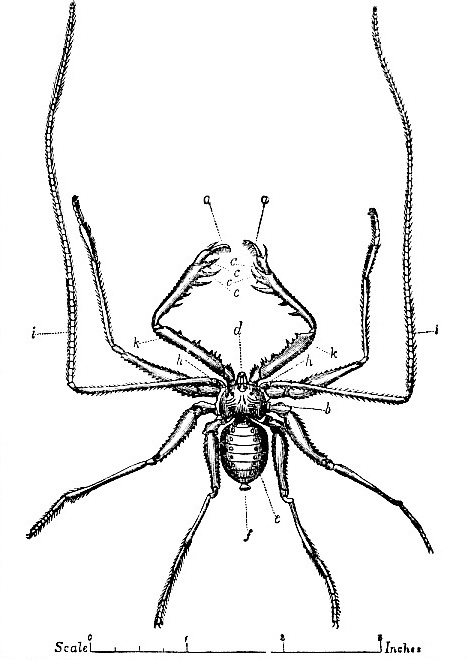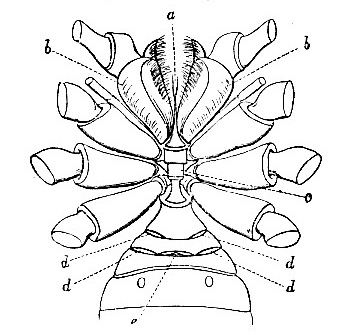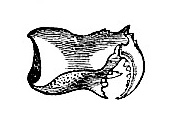(23) ARACHNIDA - ORDER VI: THELYPHONIDEA - FAMILY III: PHRYNIDES
This is also a remarkably homogeneous family, and although, undoubtedly, a near ally of the Thelyphonides, yet in its form ir presents many typical characters of the Araneidea (figs. 23-24, 25).

Fig. 23 -- Phrynus medius, Koch. a, a, movable fangs or claws on fourth joint of palpi; k, k, forming with claws, c, c, on third joint, modified didactyle claw; b, cephalo-thorax; d, falces; e, abdomen; f, button at end of ditto; h, h, eyes; i, i, long palpiform legs.

Fig. 24 -- Phrynus ___ ? portion of under side. a, labium; b, b, maxillae; c, sternum; d...d, orifices of respiratory; e, genital aperture.

Fig. 25 -- Falx and fang of Phrynus reniformis, Pallas.
With respect to EXTERNAL STRUCTURE, the body is short and broad instead of elongated, as in Thelyphonus and Nyctalops. The cephalo-thorax is flattened, of a round oval form, hollowed on the hiner margin, and often of a short heart or kidney shape; its integument is hard, horny, granulose, and often tuberculose; near the center is a deep fovea, or pit like indentation, from which other grooves and indentations radiate, showing, the, now soldered up, junctional lines of the caput and thorax, and thoracic segments. In these characters of the cephalo-thorax the affinity of Phrynides to the Araneidea is very plainly indicated, as it is also in the sternal plate, around which the legs are articulated.
The falces are strong and somewhat cylindrical in form. They project in a line parallel to that of the cephalo-thgorax, and each terminates with a strong curved denticulated fang, which is articulated to its upper extremity. The falces are toothed also on their under sides; the denticulations of the falces and their fangs differ a good deal in different species, and form one of the best and most tangible characters for the determination of the species (see a paper on "Phrynus," by A.G. Butler, in Ann. and Mag. N.H., Aug. 1873, pp. 117-125, pls. 6,7). In the usual position are two strong divergent maxillae, each with a broad obtusely rounded apophysis at the fore extremity on theinner side; from the extremity of each maxilla spring a long, strong palpus, in some species of great length, consisting of four or (reckoning the large terminal movable claw as a substantive joint) five joints. This palpus is armed variously with tubercles, spines, and denticulations, especially on the cubital and radial joints, where several long, strong spines, opposed by the terminal claw (or digital joint), form a powerful grasping or raptorial organ, but one considerably further removed than the analogous portion of structure in Thelyphonus from the didactyle claw of the Scorpionidea. Between the maxillae, and issuing from the fore margin of the sternum, is a narrow, elongated tapering labium, in some species bifid at its extremity; the presence of a distinct sternal lip, or labium, is another mark of affinity to the Araneidea.
The legs (seven-jointed) are long and generally slender, though the coxal joints of the three hinder pairs are long and strong, and articulated laterally to the sternum. The legs of the first pair are palpiform, and of great length and tenuity, the three terminal joints forming one long slender tapering portion, which is however subdivided into a great number of minute homogeneous articulations without any terminal claw; each tarsus of the remaining three pairs is divided into three articulations, ending with two curved claws; and in some species the tibial joint of the fourth pair is also tri-articulate. Probably the subdivision of the fourth pair of legs varies in other species also. The coxal joints of the first pair are, as it were, crushed in behind the maxillae and above the coxae of the second pair, as in Thelyphonus. The extreme articulation of each tarsus has a peculiarity never (it is believed) noticed before; its upper side being covered, throughout its length, with a separate integumental plate, prolonged at its fore extremity into a corneous, slightly bent, claw-like apophysis, forming a kind of third claw above and between the two ordinary ones. These latter spring from a supernumerary or heel joint, which has a short, conical, tooth-like spur beneath it, representing the usual third claw in other groups.
The eyes, eight in number, are placed in three groups, forming a very obtuse angled triangle on the fore margin of the caput. Two eyes, seated transversely, and near together in the medial line, constitute the apex of the triangle, which is directed forwards; the other two groups are of three eyes each, closely grouped in a triangular form, one on each side, about parallel with the second pair of legs.
The abdomen is oval, of a somewhat flattened form, and joined to the cephalo-thorax by a narrow pedicle, showing, in this also, a near approach to the Araneidae, it consists of ten quasi-segments, or articulations, formed, as in the other families of the order, by a series of upper and lower transverse corneous plates, having an, apparently continuous, cartilaginous integument between the two series of plates, and terminating with a button-like joint, or process, at its extremity. On the under side are two parallel rows of impressed spots, two, in a transverse line, in each of the fourth and three following sub-abdominal plates; but, apparently, like the corresponding marks in Thelyphonus, imperforate. The organs of generation have their external orifice beneath the posterior margin of the first sub-abdominal plate; and the external openings to the respiratory organs; four in number, are situated, two beneath the posterior margin of the first, and two others beneath that of the second of these plates. The sternum is oval, and often superficially divided into several portions by various ridges and indentations.
With regard to the INTERNAL SCTRUCTURE of the Phrynides, the respiratory system is pulmo-branchial, the orifices to these organs being four in number, and placed as above mentioned.
The nervous system, according to Van der Hoeven, appears to be very simple, consisting of a large thoracic bi-lobed ganglion, from which four pairs of lateral nerves issue, while a double nervous chord runs back through the connecting pedicle into the abdomen, where it divides into two divegent branches, from which the various nerves are distributed to the different parts of the abdomen.
GENERAL REMARKS. The family Phrynides comprises but one genus, Phrynus (Olivier), which, according to the most recent publication upon it (A.G. Butler, l.c. supra), includes twenty species only, all confined to the tropical regions of the world. The individuals of most of these species appear to be of rare occurrence, or, at least, but rarely observed, and the family has, comparatively speaking, received but little attention. it is, however, one of great interest and importance, and deserves more elaborate and careful treatment, especially in regard to its habits and internal anatomy, for it undoubtedly forms a plain passage from the Scorpionidea (through Thelyphonus and Nyctalops) to the true spiders (Araneidea). The main external marks of affinity with this order have been noticed in speaking of the different portions of external strcutre of the Phrynides.
Read the rest of this article:
Arachnida - Table of Contents
|


